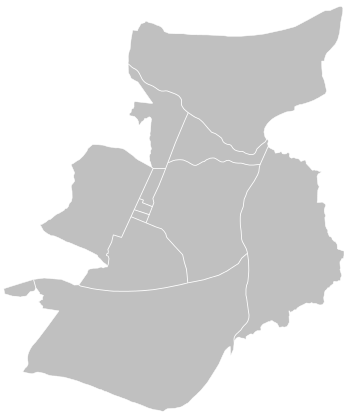Fenglin (Hualien)
|
Fenglin 鳳林 鎮 |
||
 Location of Fenglin in Hualien County |
||
| State : |
|
|
| County : | Hualien | |
| Coordinates : | 23 ° 44 ' N , 121 ° 28' E | |
| Area : | 120.518 km² | |
| Residents : | 10,851 (March 2018) | |
| Population density : | 90 inhabitants per km² | |
| Time zone : | UTC + 8 (Chungyuan time) | |
| Telephone code : | (+886) (0) 3 | |
| Postal code : | 975 | |
| ISO 3166-2 : | TW-HUA | |
| Community type : | City municipality ( 鎮 , Zhèn ) | |
| Structure : | 12 districts ( 里 , Li ) | |
| Mayor : | Wen Long ( 文 龍 ) ( KMT ) | |
| Website : | ||
|
|
||
Fenglin ( Chinese 鳳林 鎮 , Pinyin Fènglín Zhèn ), sometimes also Fonglin , is a township in the district of Hualien in the Republic of China (Taiwan) .
Location and climate
Fenglin is located in the northern section of the Huatung Valley , an elongated valley that extends parallel to the east coast of Taiwan. The western boundary of the valley and Fenglin forms the Taiwanese Central Mountains and the western boundary forms the Haian Mountains . The neighboring communities are Shoufeng in the north and northeast, Fengbin in the southeast, Guangfu in the south, and Wanrong in the west. Fenglin consists of a valley floor. In the eastern section, the Hualien River flows south-north through the municipality and is fed from the west by the central mountains through the tributaries Qingshui ( 清水溪 ), Fenglin ( 鳳林 溪 ) and Wanli ( 萬里 溪 ) . There is a subtropical, warm and rainy climate. The average temperature is between 22 and 24 degrees and the annual rainfall between 1700 and 2000 mm.
history
The natives of the area were indigenous Taiwanese Austronesians . During the Qing Dynasty , Han Chinese gradually came into the country. At the time of the Japanese colonial rule (1895–1945), the Japanese administration initiated a program to increase economic productivity, especially the cultivation of tobacco, tea and sugar cane, in the eastern regions of Taiwan. For this purpose, settlers were recruited between 1906 and 1930, mainly from today's Hsinchu and Miaoli districts, to settle in what is now Fenglin. Most of the new settlers in Fenglin were members of the Hakka ethnic group. In 1947, after Taiwan was transferred to the Republic of China , the area was organized as Fenglin Township in the newly established Hualien County.
| Outline of Fenglin |
Administrative division
After Fenglin was founded in 1946, the community was initially divided into 17 districts ( 里 , Li ). In 1978 a reorganization in 12 districts: Fengren ( 鳳仁里 ), Fengli ( 鳳禮里 ) Fengzhi ( 鳳智里 ) Senrong ( 森榮里 ) Linrong ( 林榮里 ) Nanping ( 南平里 ), Beilin ( 北 林 里 ), Fengyi ( 鳳 義 里 ), Fengxi ( 鳳 信 里 ), Shanxing ( 山 興 里 ), Dajung ( 大 榮 里 ), Changqiao ( 長橋 里 )
population
About two thirds of the population belong to the Hakka ethnic group. This is the highest percentage of any parish in eastern Taiwan. At the end of 2017, 2031 people (19%) belonged to the indigenous population. The various ethnic groups are distributed differently to the districts: Americans live mainly in Fengxi, Shanxing, Senrong and Dajung originating from the mainland Taiwanese usually live in Fengxin and Linrong. Hoklo and a few Atayal live scattered in all the villages and Hakka are concentrated in Changqiao, Nanping and Beilin.
traffic
The main traffic arteries follow the course of the Huatung valley in a north-south direction. Provincial road 9 runs on the western edge of the valley and provincial road 193 on the eastern edge. The Taitung line of the Taiwanese Railway runs largely parallel to provincial road 9 and has three stations in Fenglin (Nanping, Fenglin and Wanrong).
economy
The primary sector plays an important role. The total agricultural area is around 6,546 hectares . Mainly rice, corn, watermelon and various vegetables are grown. Livestock (pigs, cattle) and aquaculture also play a role.
particularities
The Hakka folk culture, with its customs and Hakka cuisine, are worth seeing in Fenglin. There is also a Hakka Culture Museum ( 客家 文物 館 ). The local government is keen to promote tourism and presents Fenglin as a place to relax where stressed city dwellers can switch off. Fenglin is a member of the international Cittàslow Alliance.
Web links
Individual evidence
- ↑ a b 行政 區域 ("administrative regions"). Fenglin's website, accessed June 5, 2018 (Chinese (Taiwan)).
- ↑ 移民 史 ("History of Immigration"). Fenglin's website, accessed June 5, 2018 (Chinese (Taiwan)).
- ↑ 鎮長 的 話 ("Words of the Mayor"). Fenglin's website, accessed June 5, 2018 (Chinese (Taiwan)).
- ↑ 原住民 戶數 及 人數 Households and Persons of Indigenous People. (xls) Taiwan Ministry of the Interior, accessed May 19, 2018 (Chinese / English).
- ↑ 人文 風情 ("Cultural Styles"). Fenglin's website, accessed June 8, 2018 (Chinese (Taiwan)).
- ↑ 交通 指南 ("Traffic Guide"). Fenglin's website, accessed June 8, 2018 (Chinese (Taiwan)).
- ↑ 地方 發展 ("Local Development"). Fenglin's website, accessed June 7, 2018 (Chinese (Taiwan)).
- ↑ 客家 美食 ("Hakka Kitchen"). Fenglin's website, accessed June 5, 2018 (Chinese (Taiwan)).
- ↑ 客家 文物 館 ("Hakka Cultural Museum"). Fenglin's website, accessed June 9, 2018 (Taiwanese Chinese).
- ↑ Meg Chang: National Cittàslow Alliance founded in Miaoli County. Taiwan today, March 1, 2017; accessed June 9, 2018 .





